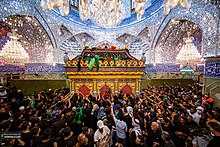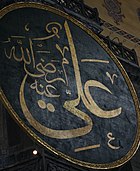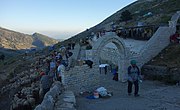|
Abbas ibn Ali
Al-Abbas ibn Ali ibn Abi Talib (Arabic: الْعَبَّاس اِبِنْ عَلي اِبِنْ أَبي طَالِبْ, c. 15 May 647 – 10 October 680 CE), also known by the kunya Abu al-Fadl (Arabic: أَبو الْفَضْل, lit. 'father of virtue'), was a son of Ali ibn Abi Talib, the fourth Rashid caliph in Sunni Islam and the first Imam in Shia Islam. His mother was Fatima bint Hizam, commonly known as Umm al-Banin (Arabic: أُمّ ٱلْبَنِين, lit. 'mother of the sons'). Abbas fought as the standard-bearer of his half-brother Husayn ibn Ali in the Battle of Karbala on 10 Muharram 61 AH (10 October 680) against the army of the Umayyad caliph Yazid ibn Mu'awiya (r. 680–683). He was killed in a desperate attempt to bring water from the Euphrates river to quench the unbearable thirst of the besieged family of the Islamic prophet Muhammad. Abbas is said to have inherited Ali's boldness and bravery, and was praised by Shia imams for his faith and fortitude in defending Husayn. Abbas is regarded by Shia Muslims as an ultimate paragon of courage and self-sacrifice. The shrine of Abbas and the nearby mausoleum of Husayn in Karbala are destinations for pilgrimage. TitlesThe kunya of Abbas was Abu al-Fadl (lit. 'father of virtue').[1] Another epithet of him was Qamar Bani Hashim (lit. 'moon of the Hashemites'), and he is often described as tall and handsome.[2] Abbas is said to have inherited the boldness and bravery of his father Ali ibn Abi Talib,[3][2] always carrying the victorious standard on the battlefield.[2] Abbas is indeed celebrated as shir-i ghazi (lit. 'the warrior-lion') and shir-i awzhan (lit. 'the valiant lion') in Persian language.[1] He is also known as Alam-d'ar (lit. 'standard-bearer') for his role in the Battle of Karbala, and as al-Saqqa' (lit. 'the water carrier') and Abu al-Qirba (qirba means 'a water-skin') for his desperate attempt on the evening of Ashura to bring water from the Euphrates river to quench the unbearable thirst of the besieged Ahl al-Bayt.[2][1] The Islamicist J. Calmard draws a parallel between Abbas and Muhammad ibn al-Hanafiyya, an elder son of Ali and his standard-bearer, saying that Abbas fulfilled the same warrior functions near Husayn.[2] Birth and early lifeAbbas was born in Medina to Ali and Fatima bint Hizam ibn Khalid ibn Rabi'a, a woman from the Banu Kilab tribe.[1] Abbas had three full brothers, named Abd Allah, Ja'far and Uthman.[2] Their mother Fatima thus became known as Umm al-Banin (lit. 'mother of the sons').[1] Abbas' brothers were all killed in the Battle of Karbala just before him.[2] Some sources refer to him as al-Abbas al-Akbar (lit. 'the elder/greater Abbas') to distinguish him from another son of Ali, named al-Abbas al-Asghar (lit. 'the younger/smaller Abbas').[1] Abbas' date of birth is disputed. According to the Sunni historian Ibn Sa'd (d. 845), he had not yet reached puberty when Ali was assassinated in 661, whereas some others have written that Abbas was thirty-four at that time. The Shia scholar Bahr al-Ulum (d. 1797) reports 4 Shaban 26 (15 May 647) as the birthdate of Abbas.[1] Naturally, much of what exists in sources about Abbas is in connection to the Battle of Karbala.[1] Battle of Karbala and death (680) Accession of YazidIn an appointment that violated earlier agreements with Ali's eldest son Hasan,[4] the Umayyad caliph Mu'awiya (r. 661–680) designated his son Yazid (r. 680–683) as his successor in 676.[5] Yazid is often presented by Muslim historians as a debaucher who openly violated the Islamic norms,[6][7][8] and his nomination was indeed met with resistance at the time from sons of some prominent companions of the Islamic prophet Muhammad, including Husayn ibn Ali.[9][10] On Mu'awiya's death and Yazid's accession in 680, the latter instructed the governor of Medina to secure Husayn's pledge of allegiance by force, and Husayn immediately left for Mecca to avoid recognizing Yazid as the caliph.[11] He was accompanied by some relatives, including Abbas.[1] Journey to KarbalaAfter receiving letters of support from Kufans, whose intentions were confirmed by his cousin Muslim ibn Aqil, Husayn left Mecca for Kufa on 8 or 10 Dhu al-Hijja (10 or 12 September 680), accompanied by few relatives and supporters.[11] A tradition attributed to Husayn identifies his intention as fighting the tyranny of Yazid, even though it would cost his life, as reported in al-Irshad, a biographical work by the prominent Shia scholar al-Mufid (d. 1022).[12][13] Husayn similarly wrote in his will for his brother Ibn Hanafiyya that he had not set out to seek "corruption or oppression" but rather to "enjoin what is right and forbid what is wrong."[14] At any rate, on their way to Kufa, Husayn's small caravan was intercepted by Yazid's army and forced to camp in the desert land of Karbala on 2 Muharram 61 (2 October 680) away from water and fortifications.[11] The promised Kufan support did not materialize as the new governor of Kufa, Ubayd Allah ibn Ziyad (d. 686), killed the envoy of Husayn and intimidated Kufan tribal chiefs.[11] Water shortageOn 7 Muharram,[15] on orders of Ibn Ziyad, the Umayyad commander Umar ibn Sa'd (d. 686) cut off Husayn's access to the Euphrates river.[16][11] Abbas and some fifty companions were nevertheless able to bring back some water to Husayn's camp in a night sortie.[11] Despite this attempt, the Islamicist L. Veccia Vaglieri (d. 1989) believes that the camp suffered from thirst for three days.[17] Among other experts, D. Pinault similarly writes that the camp suffered from thirst and hunger during the siege,[18] and the opinion of A. Hamdar is close.[19] Karbala has a hot desert climate.[20][21] NegotiationsIbn Sa'd was instructed by Ibn Ziyad not to let Husayn leave unless he pledged his allegiance to Yazid.[16] Husayn did not submit to Yazid,[11][17] but negotiated with Ibn Ziyad through Ibn Sa'd to be allowed to retreat and avoid bloodshed. The governor did not relent, however,[17][11] and finally ordered Ibn Sa'd to fight, kill, and disfigure Husayn and his supporters unless they pledged allegiance to Yazid, in which case their fate would be decided later.[11] Safe passageAs a member of the Banu Kilab, the Umayyad commander Shamir ibn Dhi al-Jawshan acquired safe passage for Abbas and his three (full) brothers from Ibn Ziyad. According to the early historian Abu Mikhnaf (d. 773–774), Ibn Ziyad's letter of protection was sent to Abbas and his brothers, who refused it, "God's protection is better than the one offered by Sumayya's son [Ibn Ziyad]." Shamir extended again this offer to Abbas and his brothers on the eve of the battle, but they remained defiant and pledged their full support to Husayn.[1] Tasu'aIbn Sa'd decided to attack on Tasu'a (9 Muharram) after the afternoon prayer. As the Umayyad army approached, however, Husayn dispatched Abbas and some companions, who requested Ibn Sa'd to delay the confrontation until the following day.[1][11] Husayn now beseeched his followers in a speech to leave and not risk their lives for his sake, after which Abbas was the first to renew his support, saying that he would follow his brother in life or death.[1] Nearly all those present stayed with Husayn until the end.[11][21][22] Husayn and his companions spent that night praying and reading the Quran,[23] as reported by the Shia jurist Ibn Tawus (d. 1266) and in most maqatil works.[24] On this night, Zaynab bint Ali is said to have reminded her half-brother Abbas of their father's wish for the latter to be the reserves of Karbala, and to be to Husayn as Ali was to Muhammad. This Abbas confirmed and swore to do.[25] There is a report by Ibn Tawus that Abbas was killed on Tasu'a in a failed sally to bring water,[2][24] though most traditions place his death on Ashura.[2] Ashura c. 1868–1933 On the morning of Ashura (10 Muharram), Husayn organized his supporters, some seventy-two men,[17] and designated Abbas as his standard-bearer, an indication of his privileged position among the companions.[1] Husayn then spoke to the enemy lines and asked them why they considered it lawful to kill the grandson of Muhammad.[17] The Umayyad commander al-Hurr ibn Yazid al-Tamimi defected to Husayn's side, probably after this speech.[26] The Umayyad army then showered the camp with arrows,[17] thus commencing the battle which lasted from morning till sunset and consisted of incidents of single combat, skirmishes, assaults, and retreats.[11] On one occasion, Abbas helped rescue a group of companions who were surrounded by enemy horsemen.[1] By the early afternoon, however, the companions had all fallen and were followed by the Banu Hashim.[27] DeathThe Sunni historians al-Tabari (d. 923) and al-Baladhuri (d. 892) are silent in their works about the details of Abbas' death.[2][17] Veccia Vaglieri, however, argues that there must have existed traditions about his death and that those were reported by al-Mufid,[17] to the effect that Abbas and Husayn were separated when they attempted to reach the Euphrates in the ultimate episode of the battle, adding that Abbas fought valiantly until the end.[2][17] Another well-known account is reported by the Shia scholar Ibn Tawus and some others:[2] Perhaps anguished by the cries of Husayn's thirsty children,[28] Abbas set out for the Euphrates on the eve of Ashura and managed to fill his water-skin, but was blocked by the enemy near the river bank, far from Husayn's camp.[1] Fighting alone, both his arms were severed and he was then killed.[2] When Husayn's last warrior fell, the Umayyad army converged on the lone imam, who also fought until the end.[21] The account by the Sufi scholar H. Kashefi (d. 1504) in his Rawzat al-shohada differs in that it places Abbas as the sixty-eighth casualty before Mohammad ibn Ali, Ali al-Akbar, and Ali al-Asghar.[2] Zayd ibn Varqa' Hanafi and Hakim ibn al-Tofayl San'ani are named as the murderers of Abbas in al-Irshad.[2] Abu Mikhnaf in his Maqtal adds that Husayn wept bitterly when his brother fell.[29] Maqatil al-Talibiyyin by the early historian Abu al-Faraj al-Isfahani (d. 967) reports that the murderer of Abbas dreamed of being flung into hell every night,[30] while reports attributed to the Shia imams Ali ibn al-Husayn (d. 713) and Ja'far al-Sadiq (d. 765) highly praise Abbas for his faith and fortitude in defending Husayn.[1] CredibilityAmong others, al-Mufid argues that Abbas' burial place, far from Husayn and his companions, adds to the credibility of this account, which is also corroborated by another report about Abbas' death attributed to Ali ibn al-Husayn. In support of this account, the Islamicist A. Bahramian and his co-author note that the traditional supplications for pilgrims contain references to Abbas' mission to fetch water and his arms being severed. The two authors also note that Abbas later became known as al-Saqqa' (lit. 'the water carrier') and Abu al-Qirba (qirba means 'a water-skin').[1] After his deathAfter the battle, some Umayyad soldiers stripped Abbas' garments,[1][22] and his corpse was thus dishonored.[31] As with Husayn and his other companions, the head of Abbas was severed and brought to Yazid in Damascus,[2] in his case by Harmala ibn K'ahil al-Asadi.[1] Shrine Abbas was buried by some men of the Banu Asad tribe from nearby al-Ghadiriyya village, at the same place where he was killed. A tomb was later erected over his grave.[17][32] Abbas' shrine now has a golden dome and is located to the north-east of Husayn's mausoleum. Both shrines are built on a mound overlooking the city of Karbala,[2] which has become a destination for pilgrimage and a center for religious learning.[32] There exist special prayers and rituals for pilgrims and several Muslim figures are buried in the precinct of Abbas' shrine.[2] There are also other shrines associated with Abbas elsewhere, including an old shrine near Tehran, considered by the locals to be the tomb of Abd Allah ibn Abbas.[1] DescendantsAbbas had a young son named Ubayd Allah, born to Lubaba bint Ubayd Allah, the grand-daughter of Abbas ibn Abd al-Muttalib. This son was likely taken captive after the Battle of Karbala, and the lineage of Abbas continued through him. In particular, the poetry by Abbas' descendants is collected in one of the chapters in al-Awraq by the Abbasid-era author al-Suli (d. 946–947). One of his descendants was Abbas ibn al-Hasan al-Alawi, who reached fame as a poet and scholar during the reigns of the Abbasid caliphs, al-Rashid (r. 786–809) and al-Ma'mun (r. 813–833). The Zanj rebellion was ignited in Iraq and Bahrain in the ninth century by Ali ibn Muhammad Sahib al-Zanj, who claimed descent from Abbas.[1] However, this claim has been disputed by some historians.[33] Significance in Shia IslamAbbas is regarded in Shia Islam as an ultimate paragon of courage, chivalry, love, sincerity, and self-sacrifice. Shias make the supplication of tawassul to Abbas, thus requesting him to join his prayers with them. Abbas is thus associated in Shia with the alleviation of grief and suffering. Serious oaths are made in his name, and Shias distribute food for charity as part of vows (nadhrs) made in the name of Abbas.[1] Muharram ritualsTasu'a (9 Muharram) is devoted in Shia as the day of mourning for Abbas.[1] He is celebrated in religious passion-plays (ta'zies) as the water carrier of the Ahl al-Bayt and the standard bearer of Husayn.[2] The ta'zie of Abbas' death is among the oldest passion-plays and is frequently performed throughout the year.[1] The green standards (alams) carried in Muharram processions are often adorned on top with a metal hand (panja) representing Abbas' severed hand, with outstretched fingers that symbolize the Ahl al-Bayt.[2][1] They are engraved with the invocations such as Ya hazrat-e Abbas (lit. 'O, exalted Abbas') or Ya Abu al-Fadl.[2] Food and water are also distributed for charity in his name.[2] From West Indies to the island of Java, Sunnis and Hindus also commonly participate in most Shia Muharram rituals.[2] Religious artAbbas is heavily featured in Shia art. Verses of poetry about him and his likeness historically appear in public religious buildings, particularly in the tile work (kashik'ari) of saqqa-khanas (public drinking-water repositories), husayniyyas and takiyyas (both are places to commemorate Husayn), and zur-khanahs (traditional Persian gymnasiums). Abbas is depicted in religious paintings often seated on a white horse and holding Husayn's banner while fighting enemies or holding a water-skin and surrounded by the womenfolk and children of the Ahl al-Bayt.[1] Significance in BektashismAccording to the traditions of the Bektashi Order, a Sufi community based primarily in Albania, Abbas ibn Ali (Albanian: Abaz Aliu) went to Albania on a white horse to save it from the barbarians and continues to return to Mount Tomorr in Albania for five days (August 20–25) each year, during which animal sacrifices are made and homage is paid to Abbas. During these five days, Bektashi pilgrims visit the Abbas Ali Türbe, a mausoleum (Albanian: mekam) believed to house the remains of Abbas. The mausoleum is located on the southern peak of the Mount Tomorr, which was originally constructed in 1620. The mausoleum lies adjacent to the Bektashi tekke on Mount Tomorr, which was built in 1916.[34][page needed]
See alsoReferences
Sources
External linksWikimedia Commons has media related to Abbas ibn Ali. |
|||||||||||||||||||||||||||||||||||||




